
Aimé Jacques Alexandre Bonpland was a French explorer and botanist who traveled with Alexander von Humboldt in Latin America from 1799 to 1804. He co-authored volumes of the scientific results of their expedition.

Iochroma is a genus of about 34 species of shrubs and small trees belonging to the nightshade family Solanaceae and found in the forests of South America and Mexico. They range from Colombia to Argentina or when certain species are excluded from Colombia to Peru. Their hummingbird-pollinated flowers are tubular or trumpet-shaped, and may be blue, purple, red, yellow, or white, becoming pulpy berries. The cupular (cup-shaped) calyx is inflated in some species. The leaves are alternate, simple, and entire.

Nicandra physalodes is a species of flowering plant in subfamily Solanoideae of the nightshade family. It is known by the common names apple-of-Peru and shoo-fly plant. It is thought originally to have been native to western South America, including Peru, and is known elsewhere as an introduced and ruderal species – sometimes as a weed – in tropical, subtropical and, to a lesser extent, temperate areas all over the world. It has also long been cultivated as an ornamental plant for its attractive flowers and curious fruits and has been adopted into the traditional medicine of countries far-removed from its original home.

Withania somnifera, known commonly as ashwagandha, Indian ginseng, poison gooseberry, or winter cherry, is a plant in the Solanaceae or nightshade family. Several other species in the genus Withania are morphologically similar. Although thought to be useful as a medicinal herb in Ayurveda and sold in many countries as a dietary supplement, there is insufficient scientific evidence that it is safe or effective for treating any disease. Because of its lack of demonstrated efficacy and serious possible side-effects, it is currently recommended for no condition.
Iochroma brevistamineum is a species of plant in the family Solanaceae. It is endemic to Ecuador.
Iochroma lehmannii is a species of plant in the family Solanaceae. It is endemic to Ecuador, specifically in the Chimborazo Province in the High Andes. Its flowers are yellow-green.
Iochroma longipes is a species of plant in the family Solanaceae. It is endemic to Ecuador.
Palicourea fuchsioides is a species of plant in the family Rubiaceae. It is endemic to Ecuador.

Iochroma arborescens is a species of flowering plant in the genus Iochroma, belonging to the nightshade family Solanaceae. Formerly it was considered the single species in the monotypic genus Acnistus. Common names include gallinero, mata-gallina, fruta-de-sabiá, hollowheart, wild tobacco, siyou, bastard sirio, galán arbóreo, tabaco de monte, nigüito, marieneira, güitite, and tabak djab.

Withanolides are a group of at least 300 naturally occurring steroids built on an ergostane skeleton. They occur as secondary metabolites primarily in genera of the Nightshade family, for example in the tomatillo.
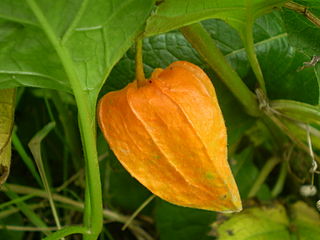
Physaleae is a tribe of flowering plants in the subfamily Solanoideae of the family Solanaceae.

Withaferin A is a steroidal lactone, derived from Acnistus arborescens, Withania somnifera and other members of family Solanaceae. It has been traditionally used in ayurvedic medicine. It is the first member of the withanolide class of ergostane type product to be discovered. This natural product has wide range of pharmacological activities including cardioprotective, anti-inflammatory, immuno-modulatory, anti-angiogenesis, anti-metastasis and anti-carcinogenic properties.
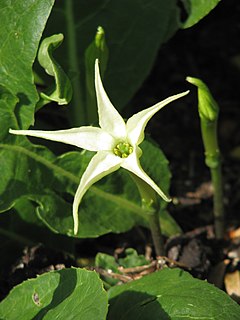
Jaborosa is a genus of flowering plants in the family Solanaceae, the nightshades. There are about 23 species, all native to South America, where they are distributed from Peru to Patagonia. Most occur in the Andes. Most can be found in Argentina and ten are endemic to the country.
Trompettia cardenasiana is a spiny shrub bearing very small leaves, 0.35–0.5 cm (0.1–0.2 in) by 0.1–0.12 cm (0.04–0.05 in), a yellow trumpet-shaped campanulate flower, measuring about 3 cm (1.2 in) long and globose fruit. The growth habit is somewhat reminiscent of certain Lycium species. It is endemic to Bolivia, growing in dry, Andean valleys at altitudes of 2,000–2,500 m (6,600–8,200 ft) and 3,000–3,500 m (9,800–11,500 ft) and has been collected near the town of Cotagaita in Potosí Department.
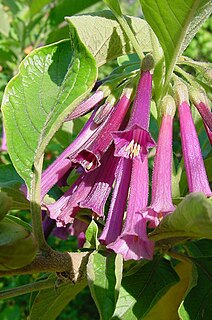
Iochroma grandiflorum is an Iochroma species found in Ecuador. It was first described in 1845

Physalis virginiana, the Virginia groundcherry, is a rhizomatous perennial with a deeply buried stem base. It is found mostly in eastern North America as far west as Wyoming.

Ergostane is a tetracyclic triterpene, also known as 24S-methylcholestane. The compound itself has no known uses; however various functionalized analogues are produced by plants and animals. The most important of these are the heavily derivatised withanolides. However simpler forms do exist, such as the sterane campestane (24R-methylcholestane). Along with cholestane and stigmastane, this sterane is used as a biomarker for early eukaryotes.
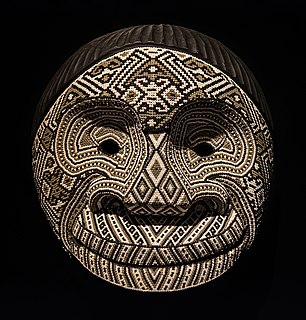
The Kamëntsá are an indigenous people of Colombia. They primarily live in the Sibundoy Valley of the Putumayo Department in the south of Colombia.
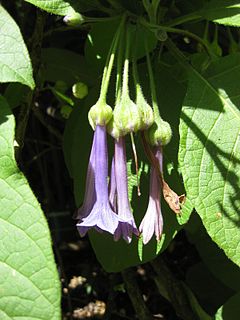
Iochroma warscewiczii is a shrub in the family Solanaceae. The species, which is native to Peru, was formally described in 1855 by German botanist Eduard August von Regel. It is named for the Polish botanist and explorer Józef Warszewicz Ritter von Rawicz (1812-1866).
Coutareopsis is a genus of flowering plants belonging to the family Rubiaceae.













